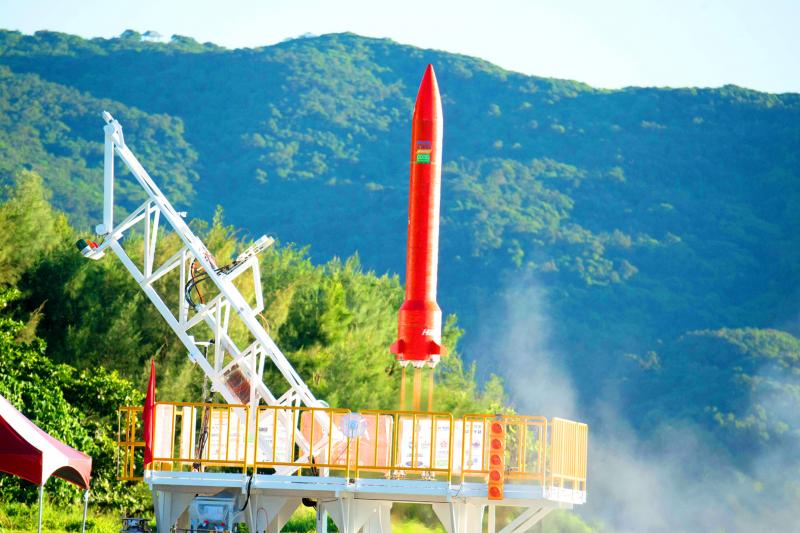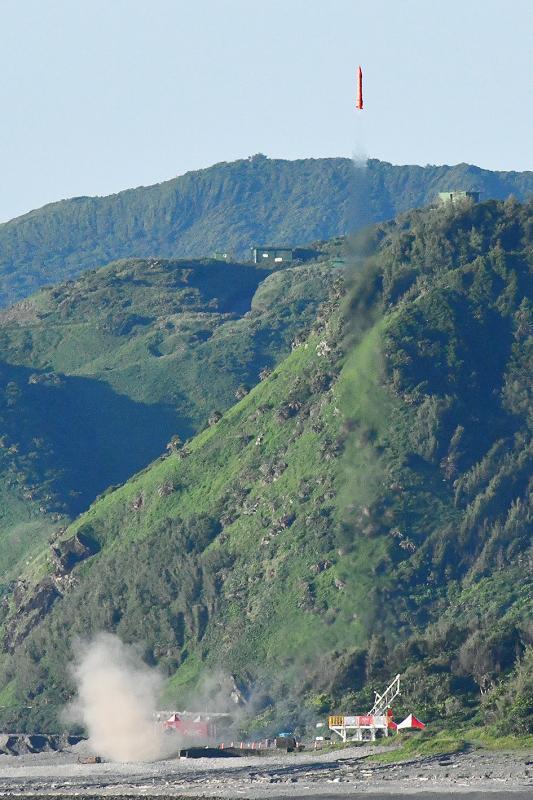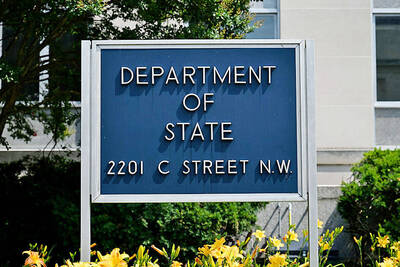Researchers from National Yang Ming Chiao Tung University’s Advanced Rocket Research Center (ARRC) yesterday successfully tested the second-stage propulsion system of a domestically designed rocket.
Minister of Science and Technology Wu Cheng-chung (吳政忠) lauded the test of the HTTP-3A sounding rocket’s propulsion system, saying it demonstrated the integration of industry and academia in Taiwan at a time when the global space industry is developing.
The test, which was originally scheduled for May 3, began at 6:12am yesterday, with the rocket launching from Syuhai Village (旭海) in Pingtung County’s Mudan Township (牡丹).

Photo provided by the National Space Center
According to the initial flight plan, the 4.8m, 365kg rocket was to lift off vertically for five seconds before arcing out over the sea, when its engine would shut off after 60 seconds and a drogue parachute would deploy after 90 seconds.
Then, after reaching a lower altitude, it would release a second parachute and land in the sea, having reached an altitude of 12km during an eight to 10-minute flight.
Yesterday’s launch fell short in that regard, as the rocket stayed in the air for two minutes and reached a maximum altitude of about 3km, but it was nevertheless “99 percent successful,” the ARRC said.

Photo: Tsai Tsung-hsien, Taipei Times
The launch tested the rocket’s hybrid propulsion system — which uses a mix of liquid and solid-state propellants — navigation system, ground controls, recovery parachute and launch preparations, it added.
The hybrid-fuel sounding rocket does not need navigation assistance to guide its flight, ARRC director Wei Shih-hsin (魏世昕) said, adding that after vertical takeoff the rocket can adjust its flight path, thrust magnitude and thrust vector by itself.
“The HTTP-3A is the world’s first hybrid rocket with guidance and control technology. Although it is not capable of flying very high, it represents a major technological breakthrough,” he said.
The launch allowed the team to test its self-developed, six degrees of freedom mission-analysis simulator, called ZIYASim, he said, adding that it was the first successful rocket launch at the launch site.
“It was much hotter than in May when we were first scheduled to launch, making it a harsher work environment, but the team lived up to expectations,” he said. “The team showed that ZIYASim achieves great accuracy, and all of the data we gathered will be used for the next stage as we move toward launching satellites.”
The media’s reporting of the launch since May has focused attention on Taiwan’s domestic space industry, and the Ministry of Science and Technology’s support made it possible to ensure that the launch site and facilities were ready in just one month, he added.
Additional reporting by CNA

A car bomb killed a senior Russian general in southern Moscow yesterday morning, the latest high-profile army figure to be blown up in a blast that came just hours after Russian and Ukrainian delegates held separate talks in Miami on a plan to end the war. Kyiv has not commented on the incident, but Russian investigators said they were probing whether the blast was “linked” to “Ukrainian special forces.” The attack was similar to other assassinations of generals and pro-war figures that have either been claimed, or are widely believed to have been orchestrated, by Ukraine. Russian Lieutenant General Fanil Sarvarov, 56, head

SAFETY FIRST: Double the number of police were deployed at the Taipei Marathon, while other cities released plans to bolster public event safety Authorities across Taiwan have stepped up security measures ahead of Christmas and New Year events, following a knife and smoke bomb attack in Taipei on Friday that left four people dead and 11 injured. In a bid to prevent potential copycat incidents, police deployments have been expanded for large gatherings, transport hubs, and other crowded public spaces, according to official statements from police and city authorities. Taipei Mayor Chiang Wan-an (蔣萬安) said the city has “comprehensively raised security readiness” in crowded areas, increased police deployments with armed officers, and intensified patrols during weekends and nighttime hours. For large-scale events, security checkpoints and explosives

PUBLIC SAFETY: The premier said that security would be tightened in transport hubs, while President Lai commended the public for their bravery The government is to deploy more police, including rapid response units, in crowded public areas to ensure a swift response to any threats, President William Lai (賴清德) said yesterday after a knife attack killed three people and injured 11 in Taipei the previous day. Lai made the remarks following a briefing by the National Police Agency on the progress of the investigation, saying that the attack underscored the importance of cooperation in public security between the central and local governments. The attack unfolded in the early evening on Friday around Taipei Main Station’s M7 exit and later near the Taipei MRT’s Zhongshan

REBUFFED: In response to Chinese criticism over recent arms sales, Washington urged Beijing to engage in meaningful dialogue instead of threats and intimidation Washington’s long-term commitment to Taiwan would not change, the US Department of State said yesterday, urging Beijing to stop pressuring Taiwan and engage in meaningful bilateral dialogues. The remarks came in response to a backlash from Beijing about Washington’s latest approval of arms sales to Taiwan. The US Defense Security Cooperation Agency said in a statement on Wednesday that the Taipei Economic and Cultural Representative Office in the US has asked to purchase an arms package, including Tactical Mission Network Software; AH-1W helicopter spare and repair parts; M109A7 self-propelled howitzers; HIMARS long range precision strike systems; tube-launched, optically tracked, wire-guided missiles; Javelin